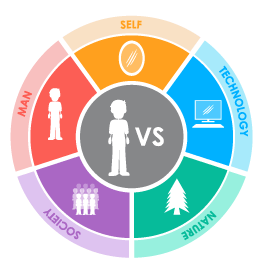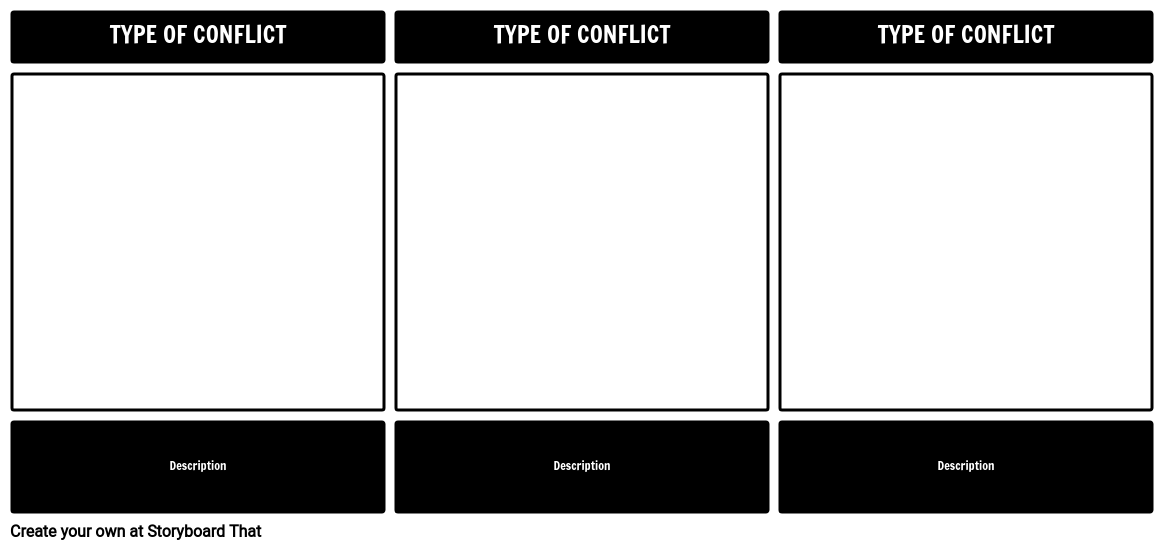Lesson Plan Overview
Storyboarding is an excellent way to focus on types of literary conflict. Have your students choose an example of each literary conflict and depict them using the storyboard creator. In the storyboard, an example of each conflict should be visually represented, along with an explanation of the scene, and how it fits the particular category of conflict.
Examples of Literary Conflict from “The Tell-Tale Heart”
MAN vs. SELF
The narrator struggles to resist the awful ticking of the dead man's heart that haunts him.
MAN vs. SOCIETY
The narrator must lie to the police, and cover up the murder.
MAN vs. MAN
The narrator obsesses over the old man’s eye, eventually killing him for it.
Template and Class Instructions
(These instructions are completely customizable. After clicking "Copy Activity", update the instructions on the Edit Tab of the assignment.)
Student Instructions
Create a storyboard that shows at least three forms of literary conflict in “The Tell-Tale Heart”.
- Identify conflicts in “The Tell-Tale Heart”.
- Categorize each conflict as Character vs. Character, Character vs. Self, Character vs. Society, Character vs. Nature, or Character vs. Technology.
- Illustrate conflicts in the cells, using characters from the story.
- Write a short description of the conflict below the cell.
Lesson Plan Reference
Student Rubric
(You can also create your own on Quick Rubric.)
| Proficient | Emerging | Beginning | Try Again | |
|---|---|---|---|---|
| Conflict Identification | Student identifies correct major conflicts and uses strong, clear textual evidence to support choice. | Student identifies correct major conflict and uses few or unclear details to support their choice. | Student identifies incorrect major conflict, and uses some details from the text to support their choice. | Student does not attempt to identify major conflict or identifies incorrect major conflict with no explanation. |
| Understanding Outcome | Student clearly shows the outcome of the conflict and its effects on the protagonist with evidence from the text. | Student shows the outcome of the conflict and its effect on the protagonist, but some evidence is unclear. | Student shows the outcome of the conflict, but does not examine its effect on the protagonist and uses some vague textual evidence. | Student does not clearly show the outcome of the conflict or use textual evidence. |
| Character | Storyboard includes all required characters and clearly names them. Goes above and beyond by adding additional details. | Storyboard includes all required characters and clearly names them. | Storyboard includes protagonist and antagonist but leaves out other required characters. | Storyboard does not include the names of required characters. |
| Storyboard | Student clearly shows effort to convey the setting the scene of the book | Student attempts to convey setting and scene of the book, but lacks some clarity. | Student does not clearly convey the setting and scene. | Student makes little or no attempt to convey the setting or scene. |
| Spelling and Grammar | Student uses exemplary spelling and grammar. There are no errors. | Student makes a minor error in spelling and grammar. | Student makes several minor errors in spelling and grammar. | Student makes many errors in spelling and grammar; little attempt at spellchecking. |
Lesson Plan Overview
Storyboarding is an excellent way to focus on types of literary conflict. Have your students choose an example of each literary conflict and depict them using the storyboard creator. In the storyboard, an example of each conflict should be visually represented, along with an explanation of the scene, and how it fits the particular category of conflict.
Examples of Literary Conflict from “The Tell-Tale Heart”
MAN vs. SELF
The narrator struggles to resist the awful ticking of the dead man's heart that haunts him.
MAN vs. SOCIETY
The narrator must lie to the police, and cover up the murder.
MAN vs. MAN
The narrator obsesses over the old man’s eye, eventually killing him for it.
Template and Class Instructions
(These instructions are completely customizable. After clicking "Copy Activity", update the instructions on the Edit Tab of the assignment.)
Student Instructions
Create a storyboard that shows at least three forms of literary conflict in “The Tell-Tale Heart”.
- Identify conflicts in “The Tell-Tale Heart”.
- Categorize each conflict as Character vs. Character, Character vs. Self, Character vs. Society, Character vs. Nature, or Character vs. Technology.
- Illustrate conflicts in the cells, using characters from the story.
- Write a short description of the conflict below the cell.
Lesson Plan Reference
Student Rubric
(You can also create your own on Quick Rubric.)
| Proficient | Emerging | Beginning | Try Again | |
|---|---|---|---|---|
| Conflict Identification | Student identifies correct major conflicts and uses strong, clear textual evidence to support choice. | Student identifies correct major conflict and uses few or unclear details to support their choice. | Student identifies incorrect major conflict, and uses some details from the text to support their choice. | Student does not attempt to identify major conflict or identifies incorrect major conflict with no explanation. |
| Understanding Outcome | Student clearly shows the outcome of the conflict and its effects on the protagonist with evidence from the text. | Student shows the outcome of the conflict and its effect on the protagonist, but some evidence is unclear. | Student shows the outcome of the conflict, but does not examine its effect on the protagonist and uses some vague textual evidence. | Student does not clearly show the outcome of the conflict or use textual evidence. |
| Character | Storyboard includes all required characters and clearly names them. Goes above and beyond by adding additional details. | Storyboard includes all required characters and clearly names them. | Storyboard includes protagonist and antagonist but leaves out other required characters. | Storyboard does not include the names of required characters. |
| Storyboard | Student clearly shows effort to convey the setting the scene of the book | Student attempts to convey setting and scene of the book, but lacks some clarity. | Student does not clearly convey the setting and scene. | Student makes little or no attempt to convey the setting or scene. |
| Spelling and Grammar | Student uses exemplary spelling and grammar. There are no errors. | Student makes a minor error in spelling and grammar. | Student makes several minor errors in spelling and grammar. | Student makes many errors in spelling and grammar; little attempt at spellchecking. |
How To Explain the Interconnection of Different Types of Conflicts
Introduce Different Conflicts
Begin by explaining the different types of conflicts to the student. The most basic distinction is the internal vs. External conflict. Within these categories, there are other types as well. Give students some examples from each type so they are well-familiarized with identifying different conflicts.
Examine Character Motivations
Consider the causes of the characters' disputes. Recognize the causes of their internal unrest or their conflicts with outside powers. Think about their hopes, fears, principles, and objectives. Ask the students to think out loud and list down these motivations as they will be later used to identify conflicts.
Determine the Conflicts Present
To start, ask the students to determine the particular sorts of conflicts that are present in the narrative. Determine which characters are going through internal turmoil and what forces they are battling from the outside. For instance, in Tell-Tale Heart the conflict of character vs. Character, character vs. self, and character vs. society are more dominant.
Examine the Links Between Conflicts
Think about the connections between the internal and external conflicts. Do the character's internal conflicts affect how they handle problems from the outside? Does fighting on the outside make their internal problems worse? Look for connections between causes and effects. For instance, In Tell-Tale Heart, somehow the conflict that the narrator had with himself was linked with his conflict with society and his desperate need for people to believe in his sanity.
Frequently Asked Questions About "The Tell-Tale Heart" Literary Conflict
What role do the character vs. character and character vs. self conflicts play in the story?
The story's primary motivating factor is the narrator's internal turmoil. His fascination and obsession with the elderly man's eye and his conviction that it is "vulture-like" causes him to become more anxious and paranoid. The old man's murder serves as the final resolution to this. It also sheds some light on the type of character vs. self conflicts that can drive madness in a person.
How does "The Tell-Tale Heart"'s exterior conflict manifest itself?
The story's main external conflict is between the narrator and the elderly guy. The old man's eye becomes the narrator's fixation, and his conviction that it is malicious and judgmental causes him to want to get rid of this source of discomfort, which finally leads to the murder. Another external conflict in the story is that of the narrator vs. society. The society believes the narrator to be insane whereas, the narrator wants society to believe in his sanity which in turn drives him more insane.
More Storyboard That Activities
Tell-Tale Heart, The
Testimonials

“By using the product, they were so excited and they learned so much...”–K-5 Librarian and Instructinal Technology Teacher

“I'm doing a Napoleon timeline and I'm having [students] determine whether or not Napoleon was a good guy or a bad guy or somewhere in between.”–History and Special Ed Teacher

“Students get to be creative with Storyboard That and there's so many visuals for them to pick from... It makes it really accessible for all students in the class.”–Third Grade Teacher
© 2026 - Clever Prototypes, LLC - All rights reserved.
StoryboardThat is a trademark of Clever Prototypes, LLC, and Registered in U.S. Patent and Trademark Office







